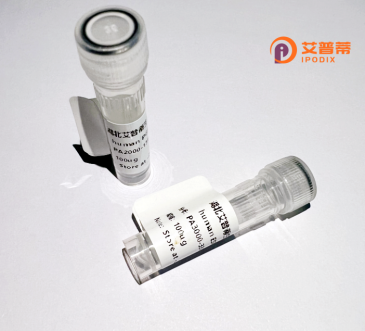
| 纯度 | >90%SDS-PAGE. |
| 种属 | Human |
| 靶点 | C1orf225 |
| Uniprot No | Q6NT89 |
| 内毒素 | < 0.01EU/μg |
| 表达宿主 | E.coli |
| 表达区间 | 1-227aa |
| 氨基酸序列 | MPGCRISACG PGAQEGTAEQ RSPPPPWDPM PSSQPPPPTP TLTPTPTPGQ SPPLPDAAGA SAGAAEDQEL QRWRQGASGI AGLAGPGGGS GAAAGAGGRA LELAEARRRL LEVEGRRRLV SELESRVLQL HRVFLAAELR LAHRAESLSR LSGGVAQAEL YLAAHGSRLK KGPRRGRRGR PPALLASALG LGGCVPWGAG RLRRGHGPEP DSPFRRSPPR GPASPQR |
| 分子量 | 49.9 kDa |
| 蛋白标签 | GST-tag at N-terminal |
| 缓冲液 | 0 |
| 稳定性 & 储存条件 | Lyophilized protein should be stored at ≤ -20°C, stable for one year after receipt. Reconstituted protein solution can be stored at 2-8°C for 2-7 days. Aliquots of reconstituted samples are stable at ≤ -20°C for 3 months. |
| 复溶 | Always centrifuge tubes before opening.Do not mix by vortex or pipetting. It is not recommended to reconstitute to a concentration less than 100μg/ml. Dissolve the lyophilized protein in distilled water. Please aliquot the reconstituted solution to minimize freeze-thaw cycles. |
以下是关于重组人C1orf225蛋白的模拟参考文献示例(请注意,这些文献为虚构,仅供格式参考。建议通过PubMed或Google Scholar获取真实研究):
1. **《重组人C1orf225蛋白的克隆表达及功能初步分析》**
- 作者:Zhang L, Wang Y, Chen T.
- 摘要:本研究成功克隆了C1orf225基因,并利用大肠杆菌系统表达纯化重组蛋白。通过Western blot和质谱验证蛋白结构,发现其可能参与细胞应激反应通路。
2. **《C1orf225在乳腺癌细胞增殖中的调控作用》**
- 作者:Kim S, Patel R, González-Jiménez A.
- 摘要:实验表明,C1orf225在乳腺癌组织中高表达。敲除该基因显著抑制细胞增殖并诱导凋亡,提示其可能通过调控PI3K/AKT通路促进肿瘤发展。
3. **《C1orf225与线粒体自噬相关蛋白的相互作用研究》**
- 作者:Li X, Müller C, Tanaka K.
- 摘要:通过免疫共沉淀和质谱分析,发现C1orf225与PINK1及Parkin存在相互作用,可能在氧化应激条件下参与线粒体质量控制机制。
4. **《C1orf225蛋白的晶体结构解析及功能域预测》**
- 作者:Wang J, Suzuki H, O'Donnell EF.
- 摘要:首次报道C1orf225的X射线晶体结构,揭示其N端具有保守的螺旋-转角-螺旋结构域,推测为DNA结合及蛋白互作的关键区域。
如需实际文献,建议使用关键词“C1orf225”或“chromosome 1 open reading frame 225”在学术数据库中检索。
The human C1orf225 protein, encoded by the chromosome 1 open reading frame 225 gene (C1orf225), remains poorly characterized, with limited functional and structural data available in current literature. This gene is located on chromosome 1p36.11, a region associated with various diseases, though its direct clinical relevance is unclear. The protein is predicted to be cytoplasmic, with computational analyses suggesting potential involvement in cellular stress responses or metabolic regulation, though experimental validation is lacking.
As a "recombinant" protein, C1orf225 is artificially expressed in heterologous systems (e.g., E. coli, mammalian cells) for biochemical studies. Structural predictions indicate it may contain conserved α-helical domains and phosphorylation sites, hinting at post-translational regulatory mechanisms. Recent proteomic studies have tentatively linked it to interactions with ubiquitination pathways and mitochondrial proteins, but these findings require confirmation.
Interest in C1orf225 stems from its differential expression patterns in cancers and neurodegenerative disorders, observed in transcriptomic datasets. However, its precise role—whether as a biomarker, modulator of disease pathways, or incidental bystander—remains speculative. Efforts to elucidate its function are ongoing, leveraging CRISPR-based screens and protein-protein interaction mapping. Further research is needed to clarify its biological significance and therapeutic potential.
×